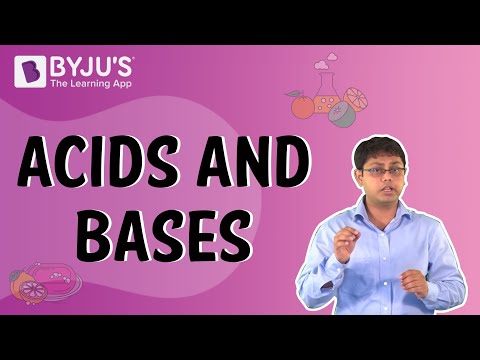According to the CBSE Syllabus 2023-24, this chapter has been renumbered as Chapter 4.
Acids and Bases
Acids
- Acids are substances that taste sour and are corrosive in nature.
- It turns blue litmus paper to red.
- These substances are chemically acidic in nature. For example, orange juice, curd, vinegar, hydrochloric acid etc.
Bases
- Bases are substances that, in aqueous solution, are slippery to the touch and bitter in taste.
- It turns red litmus paper to blue.
- These substances are chemically basic in nature. For example, soap, ammonium hydroxide, calcium hydroxide, etc.
For more information on Acids and Bases, watch the below video

To know more about Acid and Base, visit here.
Neutralisation Reaction
- When an acid and base react with each other to form salt, water and heat, then such a reaction is known as a neutralisation reaction.
- In this reaction, the acidic and basic nature of the acid and base, respectively, are destroyed.
- The reaction between hydrochloric acid and sodium hydroxide is a classic neutralisation reaction where sodium chloride is formed.
HCl+NaOH→NaCl(salt)+H2O
To know more about Neutralisation Reaction, visit here.
Salts
Salts
- Salt is the product formed from the neutralisation reaction of acids and bases.
- In the reaction between hydrochloric acid and sodium hydroxide, the salt formed is sodium chloride.
HCl+NaOH→NaCl+H2O
- Salt can be acidic, basic or neutral in nature.
To know more about Salts, visit here.
Visual Indicators
Indicators
Substances, which are used to test whether a substance is acidic or basic, are called indicators.
| Acidic Solution | Basic Solution | |
| Red litmus | No change | Turns blue |
| Blue litmus | Turns red | No change |
Natural Indicators
- Plants or plant parts contain useful chemicals that are used for testing an acidic or basic property of a solution and are termed natural indicators. China Rose and turmeric are examples of natural indicators.
Litmus
- Litmus is a naturally occurring purple indicator which is extracted from lichens.
- When added to an acidic solution, it turns red, and when added to a basic solution, it turns blue.
- It is available in the form of a solution or as strips of paper, known as litmus paper.
(B) Blue litmus turns red, indicating an acidic solution
Phenolphthalein
- Phenolphthalein is an acid-base indicator which is colourless in an acid solution but turns pink to red as the solution becomes alkaline.
- It is a synthetic indicator and is used for the neutralisation experiment.
To know more about Phenolphthalein, visit here.
Olfactory Indicators
- Olfactory indicators are substances whose smell changes whether they are mixed with an acidic or a basic solution.
- Onion, clove oil and vanilla extract are examples of such indicators.
Visual Indicators
- Visual Indicators are substances used to show visually (as by a change in colour) the condition of a solution with respect to the presence of a particular material (as a free acid or base).
- Common examples are litmus, red cabbage, phenolphthalein, etc
Neutralization
Neutralisation in Daily Life
- During indigestion, taking milk of magnesia (magnesium hydroxide) gives us relief as it neutralizes the effect of excess acid produced inside the stomach.
- The effect of ant sting, which is caused by formic acid, can be neutralized by rubbing moist baking soda (basic in nature).
- To ensure that plants can grow well, the soil is treated with either acids or bases, depending if it’s basic or acidic in nature.
- Factory wastes, generally acidic in nature and can cause environmental damage, are treated with basic substances before discharge.
To know more about “Neutralisation in Daily Life”, visit here.
Recap of Concepts
Safety Measures While Using Acids
- When diluting acids, pour the acid into the water, NOT water into acid, as this may cause spattering of the acid.
- Safety gloves are to be worn whenever working with acids or bases.
Uses and Applications
pH of Soil
- Excessive use of chemical fertilisers changes the pH of the soil.
- Plants do not grow well when the soil is either too acidic or too basic.
- Hence substances are added to bring the pH to a neutral level.
Uses of Acids and Bases
- Food preservation – Citric acid.
- Aerated drinks – Carbonic acid.
- Baking powder – Tartaric acid.
- Cooking – Acetic acid(vinegar)
- Manufacture of soaps – Sodium hydroxide.
- Manufacture of bleaching powder – Calcium hydroxide
- As a foaming agent in fire extinguishers – Aluminium hydroxide.
Frequently Asked Questions on CBSE Class 7 Science Notes Chapter 5 Acids and Bases
What is the neutralisation reaction?
A neutralization reaction is a chemical reaction where an acid and a base are combined with the intent of producing a neutral pH level.
What is litmus?
Litmus paper is colouring matter from lichens that turn red in acid solutions and blue in alkaline solutions and is used as an acid-base indicator.
What is an olfactory indicator?
An olfactory indicator is a substance whose smell varies depending on whether it is mixed with an acidic or basic solution.
Comments